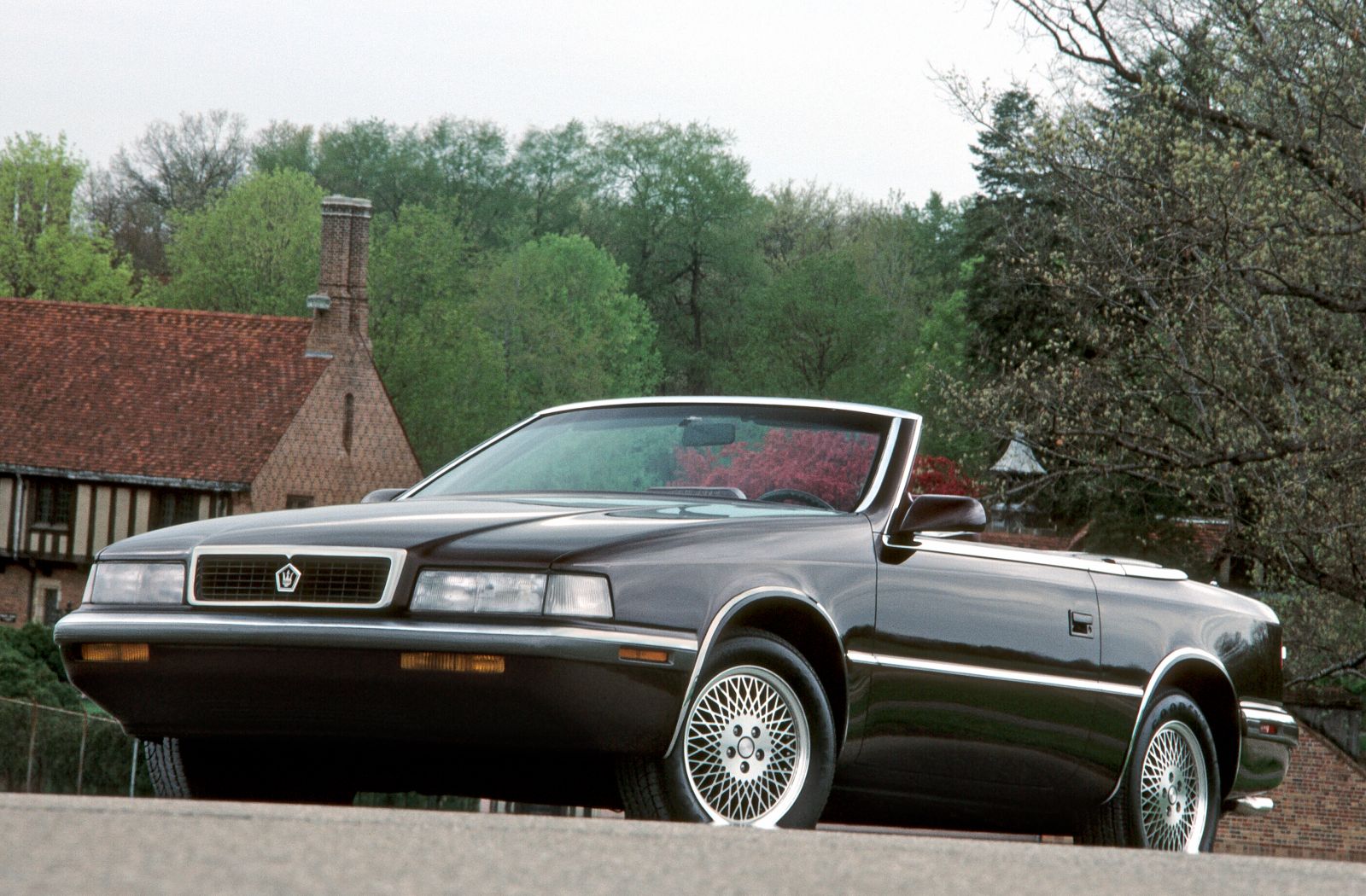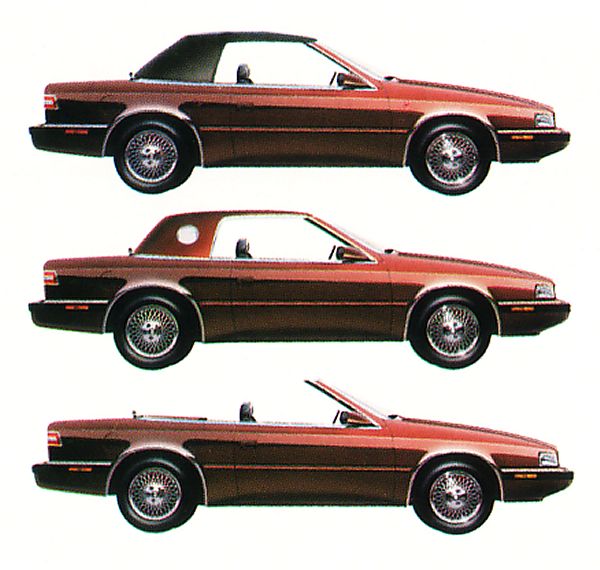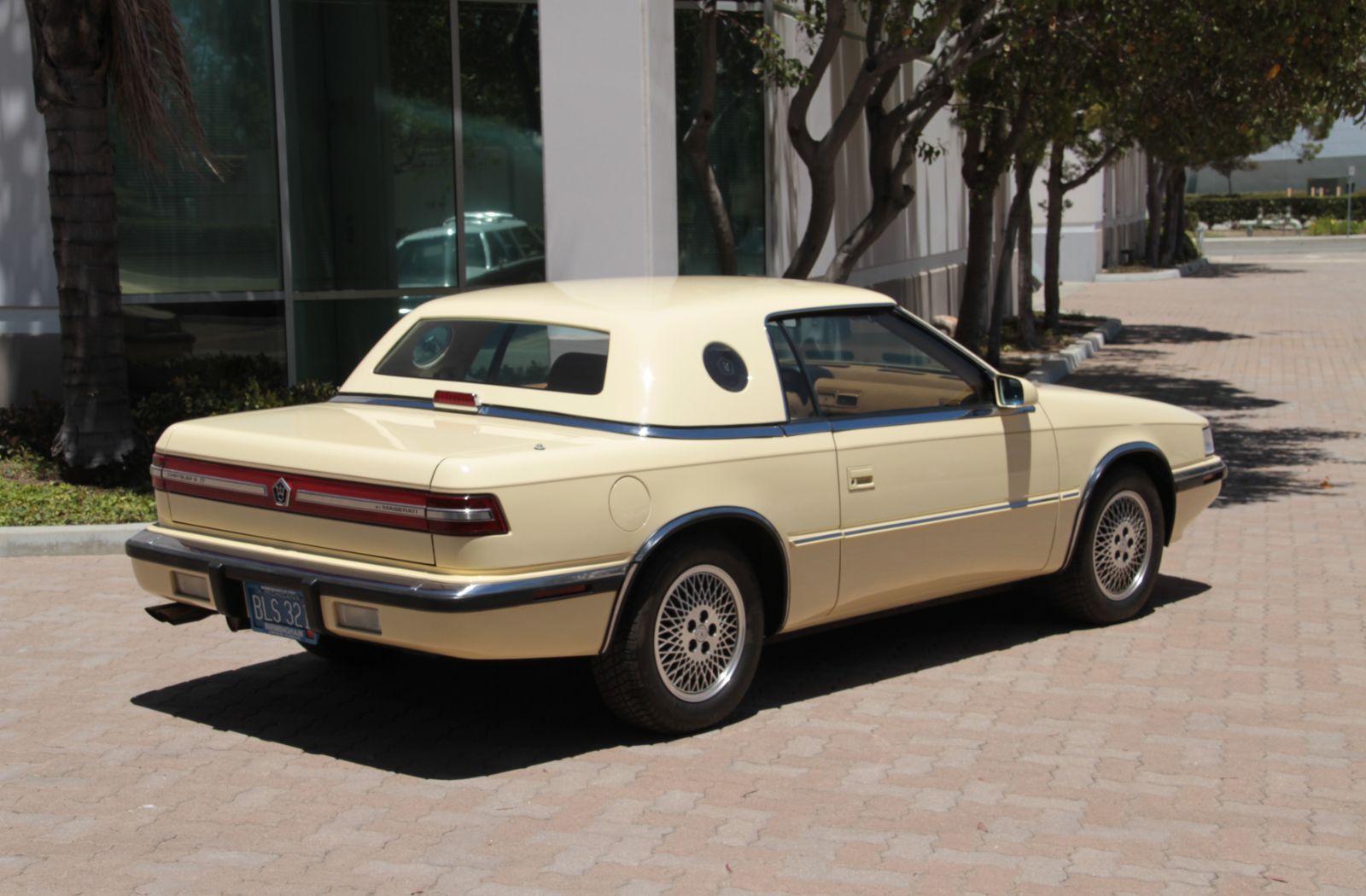Having stabilized Chrysler somewhat with sales winners like LeBaron, the bestselling convertible in America, and Town & Country, Caravan, and Voyager, the bestselling minivans ever, and proving with the Charger, Daytona, and Laser that a 4-cylinder with a turbo and proper engineering could hang with competition packing 8-cylinders, Lee Iacocca decided it was time for the company to return to its former glory days of offering top level luxury performance cars.
The return of the Chrysler Imperial and TC
While Iacocca brought back the Imperial brand for 1981, sales slid quickly, ensuring its demise by the end of 1983. Returning to the drawing board in the late 1980s, Chrysler introduced the Turbo Convertible, or TC, by Maserati and the new Imperial a few years later. Both gave Chrysler a competitive edge in the luxury market competing against the likes of DeVille, Continental, Park Avenue, Allante, Reatta, and other well-known models in the segment.
With the TC largely based on the LeBaron and the Imperial based on the New Yorker, it was a tough sell. Customers saw through the modified nature of both and had difficulty justifying the premiums, despite the fact that both were considerably distanced from their cousins. Especially the TC, which was literally an international effort between Chrysler and Maserati, which begat a remarkable interior of hand-crafted Italian leathers, exquisite paint, and a one-off chassis. Buyers could also opt for the Maserati-enhanced engine, which gave the 4-cylinder a head designed by Maserati and crafted by Cosworth to help conjure up 200 HP. Backed by a Getrag 5-speed manual transmission, it gave TC a sportier feel. Meanwhile, Imperial buyers enjoyed a choice of higher-end leather or cloth upholstery, extra sound deadening material, increased soft surfaces inside, a refined suspension system, and an optional built-in hands-free phone system. Mind you, this is 1990.
Sales of both were lukewarm at best, but drew attention to the Chrysler brand, which is really what was needed. Interestingly, while neither TC or Imperial set any sales records for the years both were in production, sales of other Chrysler models saw increases, including LeBaron, New Yorker, Daytona, Dynasty, and all those minivans. Halo cars sell. Just not themselves.

1989-1991 Chrysler’s TC by Maserati
An exclusive, open-top, two-seater for Mopar customers
Lee Iacocca took the helm of the Chrysler Corporation in 1978 and his first order of business was to turn the company around. It was doing okay, but futurists were predicting a dim outlook. The idea was simple – make Chrysler great again.
One of the many paths he took was to revisit Chrysler’s past, when it produced expensive, highly-engineered, exclusive cars for a refined audience. This reputation goes back to the beginning, by the way, when Walter Chrysler reinvented the Maxwell Motor Company in his own name. His idea was not to build for the masses like Ford and Chevrolet and Dodge, but rather cater to an upscale clientele. Arguably, this philosophy hit its zenith for Chrysler in the 1950s through the mid-1960s, particularly with the concept cars jointly built with Italian coachmakers that stunned the press and public alike when they made the show circuit. Working with a small group of people inhouse, and his age-old friend, Alejandro DeTomaso, who owned Maserati at the time, the idea of the Turbocharged Coupe was spawned.
Based heavily on the LeBaron, which used a K-Car chassis, the TC would use the exclusive new Q-Chassis, which would ultimately lend the name Q-Body to the new TC. But as time wore on, the idea shifted a bit and the new car would be a convertible, but with a removable hardtop lending owners the flexibility of a closed coupe or an open-top convertible. The car would always carry a soft top which could be hidden away under a hard tonneau cover, and the name would change slightly to Turbo Convertible.
At the 1986 Los Angeles Auto Show, the all-new Chrysler’s TC by Maserati debuted to an ocean of stunned onlookers. The reception was polar, with some wondering why Chrysler would modify a LeBaron and slap a sticker price of more than $30,000 on it (about $80,000 today), while others loved it regardless of its seeming LeBaron/K-Car roots. It was obvious where Maserati worked its magic, the paintwork was outstanding and the interior was right out of a “Things Italians do Best” coffee table book. And then – nothing. The concept sat dormant until 1989, when the TC finally hit showrooms.
Fitted with all Chrysler mechanicals and electronics, the car was largely designed by Chrysler, with Maserati assembling them mostly by hand and completely designing and crafting the interior. Once complete, the cars were sent back to Chrysler for distribution. The chassis employed some specialty components, the shocks and unique antilock braking system chief among them, and the car was initially powered by the 2.2L inline 4-cylinder turbo with an automatic transmission, a modified version of which would become available a little later with a Maserati-designed head that would be made by Cosworth. This would give the 160 HP 4-cylinder an extra 40 HP. Available only with a 5-speed manual transmission, the Maserati-head TC would be the rarest, with just 501 built. Offering a slightly smoother operation with better low-end torque, the TC later arrived in showrooms packing a Mitsubishi-sourced 3.0L V-6 and an automatic transmission. With no turbo, the whole “TC” moniker became kind of weird, but it stuck. Some felt Chrysler-Mitsubishi should have engineered a turbo and intercooler for the V-6 making it very exclusive, lending a tremendous amount of power, and maintaining the TC nomenclature. But, nothing doing. Sales peaked during the inaugural year of 1989, with 3,764 sold. Just 1,900 were sold in 1990, and 1,636 in 1991. With Chrysler losing money on every TC, production ended.

Where is the Chrysler TC today?
Initially and still often today, the TC is regarded by many as a kind of loser in the autosphere, a strange reinterpretation of the popular LeBaron with fewer seats and, some argue, less attractive exterior styling. In the shadow of the Cadillac Allante and Buick Reatta convertible, the TC had its work cut out for it, and for the most part, people simply didn’t understand. Of course, it did outsell the Reatta convertible by a fair margin, but that’s really not saying a whole lot.
So why do we love it?
It’s very unique and it was a revisit of Chrysler’s glory days when the company engaged with European partners to create something remarkably special, something wholly exclusive, something future generations could look back at and be inspired. While the TC was considerably more pedestrian than those concepts from the 1950s and ’60s, it did host a spectacular interior and a robust drivetrain, although, like with everything, opinions vary on that last point. It was also a unique moment in time when manufacturers attempted to deliver greatness. Most interestingly though, the TC has gained a following of fans mostly comprised of younger people ranging from 18 to 50, which seems to indicate the values will have longevity as perhaps there will be a following that is more appreciative of the rare TC than previous audiences have been. Building on that, the TC is a perfectly sized car. While, no, it won’t seat four, it is a spectacular car to enjoy around town or on a weekend getaway. It’s easy to park, it’s fuel efficient, very comfortable, and has ample power, especially with the Maserati head. It’s no sportscar, but neither was the Allante, Reatta, or mighty Mercedes-Benz SL, for that matter. It was a car for enjoying life. It was something unique, a car not for everyone. And, again – not many remain on the road. Of the roughly 7,000 made, it’s estimated that maybe 4,000 remain, and some say even less. If you get one, expect some strange remarks, maybe some even a little hurtful. Bring a sense of humor, and remember – they’re not for everyone. And that’s what makes them great.

1990-1993 Chrysler Imperial
Reimagining the flagship – for a moment
The Imperial was introduced in 1926 as Chrysler’s top-tier model, competing with the likes of Lincoln, Cadillac, Packard, and others in the luxury car field. The model would become its own brand for 1955, shedding the Chrysler name and becoming just Imperial. For 1975, production would cease and the Chrysler Corporation would have only its New Yorker as its upscale offering.
When Lee Iacocca took over as president of Chrysler in 1978, he asked where their Eldorado competitor was. The response was lacking at best, and Iacocca insisted on the company reviving the Imperial name. Interestingly, a sharp coupe had already been on the drawing board but was suspended. Looking it over, with a few changes to the design, the new-for-1981 Chrysler Imperial was born, once again using the surname. By design, the outward appearance was unlike anything on the road – it used a subtle bustle back trunk styling similar to cars of the 1920s and ’30s, which would also be adopted by Cadillac for its 1980 Seville, and Lincoln for the 1982 Continental. The front end was slightly raked with hidden headlights and a waterfall chrome grille topped by a real crystal Pentastar hood ornament by Swarovski. The interior featured futuristic digital instrumentation and a choice of leather or velour cloth upholstery with thick carpeting and a multitude of soft surfaces. An extensive use of sound deadening materials ensured the new Chrysler Imperial was one of the quietest cars on the road. Sales were not as expected and slid from a high mark in 1981 to the lowest sales seen in 1983, the year the model was discontinued. But it was a shot in the arm financially for Chrysler, exactly what the company needed to fund more vehicles that would sell in more abundance like the minivan, convertible, and sporty hatchbacks while the New Yorker Fifth Avenue would soldier on as the Chrysler luxury flagship.
By the late 1980s, time was running short for the New Yorker – an aging rear-drive platform with a front-mounted V-8 engine, it was indeed a spectacular luxury car that competed with Cadillac and Lincoln, but Chrysler was moving further into the front-wheel drive segment and the New Yorker would need to adopt an entirely new platform. Upon that all-new chassis, the 1990 Imperial would make yet another return, a planned short appearance that would span just four years, at which point the platform and the Imperial name would be retired to make way for the new LH-platform cars, including the LHS, which would replace the Imperial as the Chrysler flagship.
The 1990s Chrysler Imperial is born
The all-new New Yorker-based Imperial debuted for the 1990 model year with a 147 HP 3.3L V-6 engine with 185 lb-ft of torque, an engine that would be replaced for 1991 with a 150 HP 3.8L V-6 that delivered a considerably improved 215 lb-ft of torque. The New Yorker lineage was almost painfully obvious to most, but a lengthened body, formalized roofline with a half vinyl treatment, specialized trim, a unique interior, and restyled front and rear ends largely rounded out the highlights and distanced it from the lesser Chrysler. The extra length offered better rear seat legroom and a slightly larger trunk; the wedgier nose featured a tall chrome waterfall grille with a specialized Imperial Eagle Pentastar hood ornament; the rear was styled with a full-width taillight design.
The overall effort was terrific, and the base MSRP at just north of $25,000 seemed a bit of a bargain considering both the Lincoln Town Car and Cadillac DeVille held MSRPs for a hair over $30,000. Granted, they hosted V-8 engines and larger interiors, however, Chrysler had an astonishing warranty program and worked very diligently in offering customers a highly-advanced optional technology package, which included a mobile phone built into the sun visor. Fully loaded, the Imperial cost nearly $28,000. Across the four years Imperial remained in production, around 41,000 were made, nearly 15,000 were sold in 1990 with subsequent years slipping annually. By the time the last Imperial rolled off the assembly line in 1993, just a hair over 7,000 were built that year.
Why do we love the 1990s Chrysler Imperial?
In a word, inimitability. With just 41,000 Imperials made across four years, it’s a cinch only a handful remain in exquisite condition. It’s another no brainer that even those in good condition are substantially rarer than other luxury cars of the same era. It’s something wholly unique and different, yet harkens back to an age when the American luxury liner was king, a car of means, a car of substance, a car of quality like few others.
While it can’t rightly be called the last of the big Chryslers, it remains the last of the Imperial line, which is unique in and of itself. The interiors are surprisingly comfortable, the large seats are well padded and supportive, the instruments are clear and legible, the sound system is terrific, and the noise levels at highway speeds measured a mere 66 decibels when new. An Imperial is about isolation, in many regards. Not feeling the road, not hearing anything from the road, and just enjoying a lofty cruise to a destination. It’s not a car you use to race through canyons, but rather make arrivals at the valet stand. It’s a car that will, indeed, draw attention because it is such a seldom seen car and commands a unique, stately presence. More than likely, it would be the only one at a local cars and coffee cruise in, and would be the perfect way to attend a car show – even if you just park it in the lot and enjoy the event. The car will be a treat to those happening upon it in the lot. One word of caution – the wire wheel covers require a key to remove them. If you buy one, it’s a good idea to make sure it comes with that key. Otherwise, enjoy having something seldom seen.